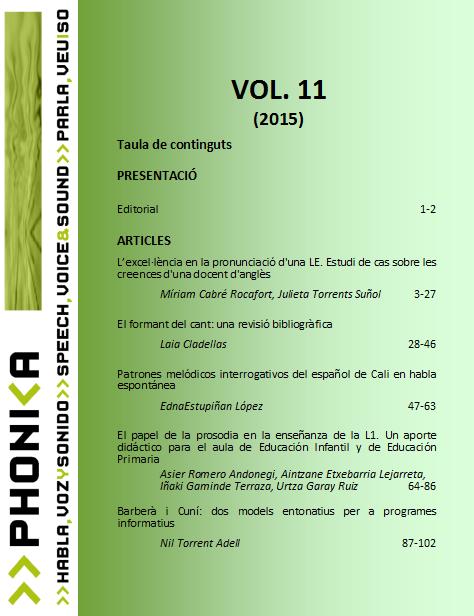El formant del cant: una revisió bibliogràfica
DOI:
https://doi.org/10.1344/phonica.2015.11.28-46Paraules clau:
Veu cantada, Formant del cant, Qualitat de la veu, AcústicaResum
El cant és la utilització de la veu com un instrument musical. La caracterització de la veu lírica cantada és moltes vegades ambigua i abstracta, però hi ha un consens general en el fet que som capaços de diferenciar una veu lírica d’altres veus cantades. Un dels paràmetres acústics diferencials de les veus líriques és l’anomenat “formant del cant”. Diversos investigadors han dut a terme estudis per tal de corroborar o no la presència del formant del cant en les veus líriques. Aquest article ofereix una revisió de conjunt.Referències
Abad Royo, JM.; Abad Marco, A.; Tísner Giraldo, B.; Pérez Sámchez, A. & Chamizo García, JJ. (2003) Trabajo de investigación y clínica aplicada. “Análisis digital de la voz. Conceptos básicos”. O. R. L. Aragón 2003’; 6 (2) 13-19.
Bartholomew, W. T. (1934): “A physical definition of good “voice quality” in the male voice,” J. Acoust. Soc. Am., 1, 24-33.
Bloothooft, G. & R. Plomp (1984): “Spectral analysis of sung vowels. I. Variation due to differences between vowels, singers and models of singing”, Journal of Acoustical Society of America, 75 (4).
Bloothooft, G. & R. Plomp (1985): “Spectral analysis of sung vowels. II. The effect of fundamental frequency on vowel spectra”, Journal of Acoustical Society of America, 77 (4).
Bloothooft, G. & R. Plomp (1986): “Spectral analysis of sung vowels. III. Characteristics of singers and models of singing”, Journal of Acoustical Society of America, 79 (3).Bretos, J & Sundberg, J. (2003): “Measurements of Vibrato Parameters in Long Sustained Crescendo Notes as Sung by Ten Sopranos”. Journal of Voice, Vol. 17, No. 3, pp. 343-352.
Cantero Serena, F. J. (2003): “Fonética y didàctica de la pronunciación”, en Mendoza, A. (coord): Didáctica de la lengua y la literatura. Madrid: Prentice Hall.Cantero Serena, F. J. (2004): “Comunicació i veu”, a Articles de didàctica de la llengua i la literatura, num. 32. (Monografia: veu i locució).
Detweiler, RF. (1994). An investigation of the laryngeal system as the resonance source of the singer’s formant. Journal of Voice, 8(4), 303-313.
Elgström, E. (2006): “Fonetometria: una proposta de protocol”, Phonica, vol. 2.
Fant, G. (1960): Acoustic Theory of Speech Production. The Hague: Mouton.García-Tapia, R. & Cobeta, I (1996): Diagnóstico y tratamiento de los trastornos de la voz. Editorial Garsi, S.A. Madrid.
González, J.; Cervera, T. & J.L. Miralles (202): “Análisis acústico de la voz: fiabilidad de un conjunto de parámetros multidimensionales”, Acta Otorrinolaringológica, 53 (256-268).
Hines, J. (1990). Great singers on great singing. New York: 5th Limelight Edition.
Hirano, M. (1981): Clinical Examination of Voice. Springer-Verlag Wien. New York.
Kenny, D. T. & Mitchell, H. F. (2006): “Acoustic and Perceptual Appraisal of Vocal Gestures in the Female Classical Voice”. Journal of Voice, Vol. 20, No. 1, pp. 55-70.Laver, J. (1980): The phonetic description of voice quality. Cambridge University Press. Great Britain.
Lindqvist, J. (1970): "The voice source studied by means of inverse
filtering", STL-QPSR 1/1970
Omori, K; Kojima, H.; Kakani, R.; Slavit, DH. & Blaugrun, SM. (1997): “Acoustic characteristics of rough voice: Subharmonics.” Journal of Voice, 11: 40-47
Rontal, E.; Rontal, M. & Rolnick, M. I (1975): “Objective Evaluation of vocal pathology using voice spectrography”. Annals of Otology, Rhinology and Laryngology. 84.
Sengupta, R. (1990). “Study on some aspects of the “Singer’s Formant” in north Indian classical singing”. Journal of Voice, 4 (2), 129-134.
Sundberg, J. (1970). “Formant structure and articulation of spoken and sung vowels”. Folia Phoniatr., 22, 28-48.
Sundberg, J. (1972): “Articulatory interpretation of the ‘singer’s formant’ ”. J Acoust Soc Am., 55, 834-844.
Sundberg, J. (1973). “The source spectrum in professional singing”. Folia Phoniatr., 25, 71-90.
Sundberg, J. (1977). “The acoustics of singing voice”. Scientific American, 236 (3), 82-84, 86, 88-91.
Sundberg, J. (1987): The science of the singing voice. Northern Illinois University Press. Dekalb, Illinois.
Sundberg, J. (2001): “Level and Center Frequency of the Singer’s Formant”. Journal of Voice, Vol15. No. 2, pp. 176-186.
Titze, I.R. & Story B. H. (1997). “Acoustic interactions of the voice source with the lower vocal tract”. J Acoust Soc Am., 101(4), 2234-2243.
Vennard, W. (1967). Singing: the Mechanism and the Technique. New York: Carl Fischer Inc.
Wang, S. (1985). “Singing voice: Bright timbre, singer’s formants and larynx positions”. SMAC83 Conference Proceedings, Stockholm, 1, 31-322.
Weiss, R., Brown, W.S Jr. & Morris, J (2001): “Singer’s Formant in Sopranos: Fact or Fiction?” Journal of Voice, Vol. 15, No. 4, pp. 457-468.
Descàrregues
Publicades
Número
Secció
Llicència
L'autor/a que publica en aquesta revista està d'acord amb els termes següents:
- L'autor/a conserva els drets d’autoria i atorga a la revista el dret de primera publicació de l’obra.
- Tots els continguts inclosos a PHONICA estan subjectes a la llicència de Reconeixement 4.0 Internacional de Creative Commons, la qual permet compartir l’obra amb tercers, sempre que en reconeguin l’autoria, la publicació inicial en aquesta revista i les condicions de la llicència.



